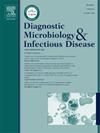人类的虫媒感染-叙述回顾
IF 1.8
4区 医学
Q3 INFECTIOUS DISEASES
Diagnostic microbiology and infectious disease
Pub Date : 2025-07-25
DOI:10.1016/j.diagmicrobio.2025.117026
引用次数: 0
摘要
cedecea属革兰氏阴性、兼性厌氧、不产孢、过氧化氢酶阳性、氧化酶阴性和活动杆状细菌,属于肠杆菌科。茜草属的成员很少被报道引起人类感染。这些感染主要发生在有严重基础疾病的免疫功能低下患者中。本综述的目的是收集和评价所有已发表的记录在案的赤蝇属人感染病例。方法检索PubMed和Scopus数据库,检索有关人感染蛲虫的流行病学、临床特征和微生物学方面的文献。结果共有49项研究涉及50例Cedecea感染患者被认为符合纳入我们的综述。患者平均年龄为53.3岁,72%为男性。88%的患者有合并症。最常见的感染类型是菌血症、呼吸道感染、软组织感染和尿路感染,其中一半以上与医疗保健有关。优势种为金雀花,其次为davisae和neteri。氨苄西林(47.6%)、庆大霉素(38.1%)、阿莫西林-克拉维酸酯、头孢菌素和头孢他啶(33.3%)的耐药率均较高。环丙沙星是最常用的抗生素,其次是美罗培南。中位治疗时间为14天。大多数患者(87.8%)的预后良好。感染导致的死亡率为10.2%。结论医师应注意这种对多种抗生素具有耐药性的罕见病原菌,根据药敏试验结果定制抗菌药物治疗方案,以达到最佳效果。本文章由计算机程序翻译,如有差异,请以英文原文为准。
Cedecea infections in humans - A narrative review
Background
Cedecea species are Gram-negative, facultative anaerobic, non-sporulating, catalase-positive, oxidase-negative and motile rod shaped bacteria belonging to Enterobacteriaceae family. Members of the genus Cedecea are rarely reported to cause human infections. These infections primarily occur in immunocompromised patients with severe underlying medical conditions. The objective of this review was to collect and evaluate all published documented cases of Cedecea spp. human infections.
Methods
We searched PubMed and Scopus databases for articles providing data related to the epidemiology, clinical features and microbiology of Cedecea human infections.
Results
A total of 49 studies involving 50 patients with Cedecea infections were regarded as eligible for inclusion in our review. The mean patient age was 53.3 years and most (72 %) were male. Comorbidities were common in 88 % of the patients. The most common types of infection were bacteremia, respiratory tract infections, soft tissue infections and urinary tract infections, and more than half of them were healthcare-associated. C. lapagei was the predominant species, followed by C. davisae and C. neteri. High rates of resistance were recorded for ampicillin (47.6 %), gentamicin (38.1 %), amoxicillin-clavulanate, cephalothin, and ceftazidime (33.3 %) each. Ciprofloxacin was the most frequently used antibiotic, followed by meropenem. The median treatment duration was 14 days. The outcome was favorable for the majority of the patients (87.8 %). The mortality rate attributed to the infection was 10.2 %.
Conclusions
Physicians should be aware of this rare pathogen that exhibits resistance to many antibiotics, so they can tailor antimicrobial treatment based on susceptibility testing results to optimize outcome.
求助全文
通过发布文献求助,成功后即可免费获取论文全文。
去求助
来源期刊
CiteScore
5.30
自引率
3.40%
发文量
149
审稿时长
56 days
期刊介绍:
Diagnostic Microbiology and Infectious Disease keeps you informed of the latest developments in clinical microbiology and the diagnosis and treatment of infectious diseases. Packed with rigorously peer-reviewed articles and studies in bacteriology, immunology, immunoserology, infectious diseases, mycology, parasitology, and virology, the journal examines new procedures, unusual cases, controversial issues, and important new literature. Diagnostic Microbiology and Infectious Disease distinguished independent editorial board, consisting of experts from many medical specialties, ensures you extensive and authoritative coverage.

 求助内容:
求助内容: 应助结果提醒方式:
应助结果提醒方式:


